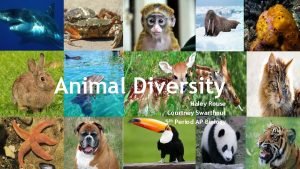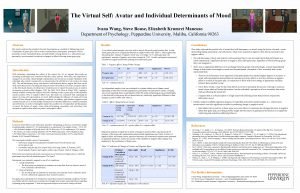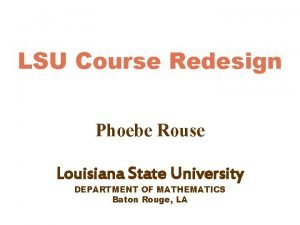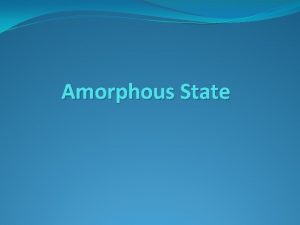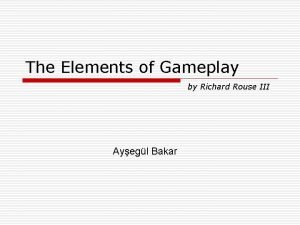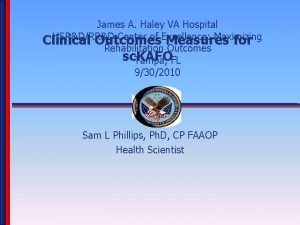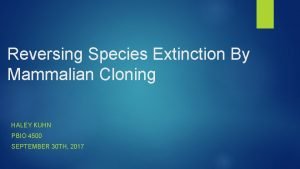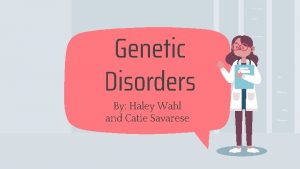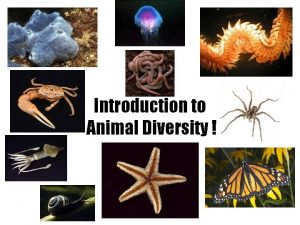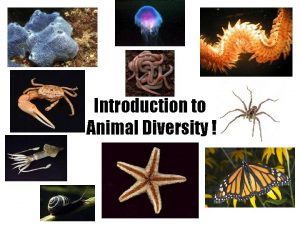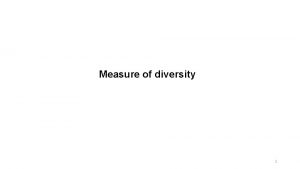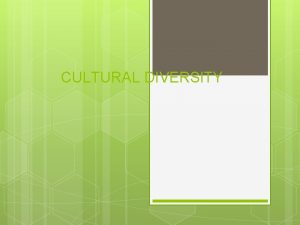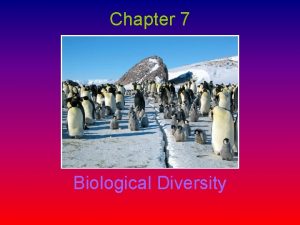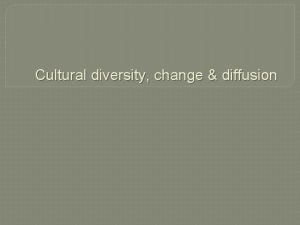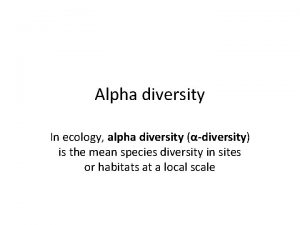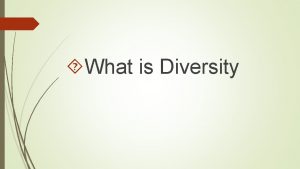Animal Diversity Haley Rouse Courtney Swarthout 5 th
















- Slides: 16

Animal Diversity Haley Rouse Courtney Swarthout 5 th Period AP Biology

Obtaining Nutrients Animals cannot make all of their own organic molecules, so they ingest them by eating other living organisms or by eating nonliving organic material, and then use enzymes to break it down inside their bodies.

Cell Structure and Specialization Eukaryotes Multicellular Lack structural support of cell walls, so instead structural proteins hold them together, the most abundant being collagen. Two Specialized Cells: muscular cells responsible for moving the body, and nerve cells for conducting nerve impulses.

Reproduction and Development Most reproduce sexually The diploid stage dominates the life cycle In most species, a small sperm fertilizes a large egg. Early Embryonic Development in Animals

Reproduction and Development Cont’d Larva: a sexually immature form of an animal that is morphologically distinct from the adult, that usually eats different food, and may even have a different habitat than the adult. Metamorphosis: a developmental transformation that turns the animal into a juvenile, which resembles an adult but is not yet sexually mature. All eukaryotes have genes that regulate the expression of other genes and many of these regulatory genes contain common sets of DNA sequences called homeoboxes.

History of Animals Ninety-nine percent of all animal species are extinct. Great diversity has its origins in evolutionary changes that occurred during the last billion years. A common ancestor of all living animals may have lived between 675 and 875 million years ago and was similar to a present-day choanoflagellates. Ediacaran biota: fossils that are members of an early group of multicellular eukaryotes. Cambrian explosion: a brief time in history when hard-bodied forms of animals appeared in the fossil record.

Body Plans Body plan: a set of morphological and developmental traits, integrated into a functioning whole. They have evolved over time. They help us categorize animals.

Symmetry This is another way for animals to be categorized. Among the animals that do not have symmetrical bodies, symmetry can take different forms. Radical symmetry: symmetry in which the body is shaped like a pie or barrel and can be divided into mirror-image halves. Bilateral symmetry: body symmetry in which a central longitudinal plane divides the body into two equal but opposite halves. Many radical animals are sessile (living or attached to a substrate) or planktonic (drifting or weakly swimming), and bilateral animals move actively from place to place.

Tissues True tissues are collections of specialized cells isolated from other tissues by membranous layers. Sponges and a few other groups lack true tissues. Germ layers form the various tissues and organs of the body. Ectoderm: the germ layer covering the surface of the embryo. Endoderm: the innermost germ layer. Diploblastic: animals that only have these two germ layers. Mesoderm: a third germ layer between the ectoderm and endoderm in all bilaterally symmetrical animals. Triploblastic: animals with three germ layers (bilaterally symmetrical animals).

Body Cavities Body cavity: A fluid or air-filled space separating the digestive tract from the outer body wall. This body cavity is also known as a coelom. Most triploblastic animals possess a body cavity. Coelom forms from tissue derived from mesoderm. Animals that possess a true coelom are known as coelomates. Pseudocoelomates: triploblastic animals that have a pseudocoelom formed from mesoderm and endoderm. Acoelomates: animals that lack a body cavity all together.

Body cavities of triploblastic animals

Animal Phylogeny Zoologists currently recognize about three dozen animal phyla. We classify organisms based on common descent. Clades are inferred from shared derived characters that are unique to members of the clade and their common ancestor. DNA sequences provide another source for inferring common ancestry and defining clades. The overall goal is to reconstruct the evolutionary history of life.

An example of animal phylogeny

Points of Agreement All animals share a common ancestor. Sponges are basal animals. Eumetazoa is a clade of animals with true tissues. Most animal phyla belong to the clade Bilateria. Chordates and some other phyla belong to the clade Deuterostomia.

Quiz 1. The diploid stage: a. Is where mitosis happens 2. What is larva? b. Dominates the life cycle a. A sexually immature animal c. Fertilizes the egg b. A sexually mature animal d. Is where cells regenerate c. An animal undergoing growth and change 3. What is a triploblastic animal? a. An animal with two germ layers d. An animal with mutated genes b. An animal with one germ layer 4. Ediacaran biota: c. An animal with three germ layers a. Is an animal with multiple ancestors d. An animal with no germ layers b. Is a fossil with multicellular eukaryotes 4. Ediacaran biota: c. Is an animal with only one ancestor a. Is an animal with multiple ancestors b. Is a fossil with multicellular eukaryotes d. Is a fossil with multicellular prokaryotes c. Is an animal with only one ancestor d. Is a fossil with multicellular prokaryotes 5. Compare and contrast radical and bilateral symmetry

Work Cited Campbell, N. , & Reece, J. (2008). AP edition Biology (8 th ed. ). New York: Benjamin/Cummings Magloire, K. (2014). Cracking the ap biology exam, 2015 edition. New York: Princeton Review. Animal Images (n. d. ). Retrieved March 21, 2015, from https: //www. worldwildlife. org/species
